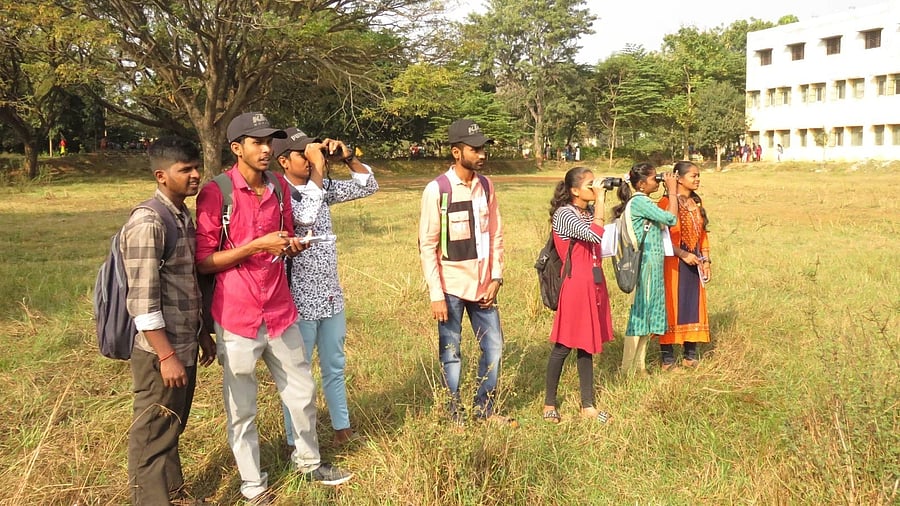
Students of Government First Grade College (Autonomous), Gubbi document birds on their campus.
Credit: Srikanth G
The very name of the place — Gubbi, a town and taluk headquarters in Tumakuru district — translates to ‘a house sparrow’ in Kannada. Called Amaragonda until about the sixteenth century, legend has it that the town earned its new name after an incident involving two house sparrows, a saint and his exposition of holy scriptures.
Centuries later, the serendipitous connection to birds has found a deeper resonance by the extraordinary efforts of the Government First Grade College (Autonomous), Gubbi. The students and faculty of the college have not just admired the birdlife around them but have systematically documented a number of species found on their campus. The outcome, an engaging e-book, Namma Campusina Hakkigalu (Birds of our campus), stands as a testament to how curiosity and commitment can transform an ordinary campus into a living laboratory for biodiversity.
It all began in 2023 when Sharath Kumar B and Thirtha Prasad, then BCom students who graduated from the college last year, were fascinated towards the birds in and around the college campus. Srikanth G, an English professor and coordinator for the college’s eco-club, nurtured their interest and guided them to identify birds, reptiles, aquatic insects and other taxa as part of the club activities.
Eventually, Sharath and Thirtha Prasad took the lead and mobilised students into an enthusiastic brigade of citizen scientists who then documented the birds, under the guidance of noted ornithologist Prashanth Badrinath. Their efforts went far beyond a routine academic exercise, becoming an opportunity for students to gain hands-on experience in biodiversity inventory and scientific documentation.
A vibrant ecosystem
Located far from the well-known biodiversity hotspots like the Western Ghats, Gubbi might not immediately come to mind as a haven for birds. Yet, despite its semi-urban setting, the college’s 10-acre campus is a thriving ecosystem. Contributing to its rich birdlife is the adjacent Maranakatte Kere, a human-made wetland, which was an irrigation tank earlier. This aquatic proximity consistently draws water birds and other species to the area.
With over 375 trees, the campus offers a variety of foods and shelter to a number of aquatic and migratory birds, especially during the rainy season and winter months. In addition, the campus is surrounded by open shrubland and agricultural fields, further expanding the habitat, attracting a diverse range of species.
The team’s effort has led to the documentation of 75 local and migratory bird species, all photographed in and around the campus. From the common kingfisher with its striking blue and orange plumage, to the diving little grebe, the regal brahminy kite, numerous warblers, prinias, and the tiny munias, each species tells a story of the vibrant life sustained within this modest patch of green.
“The eco-club has played an important role in fostering environmental awareness and strengthening the intrinsic bond between humans and nature,” said Prasanna, the college principal. He envisions the college evolving into a model biodiversity campus, an aspiration that seems well within reach given their current achievements.
In the foreword to the e-book, Mangaluru-based zoology professor Ashoka C H, notes that such practical engagement offers students an invaluable foundation for future academic and scientific pursuits. The e-book is now available free of cost for educational purposes.
Commending the efforts of the students and the faculty in bringing out the e-book, environmental science professor Prabhakar B S of St Joseph’s University, Bengaluru said such local initiatives can inspire future generations and serve as platforms to engage and enthuse the community. He recalled a similar initiative undertaken over two decades ago by the students at a college in Karkala, where one of the participants, Geetha Nayak, later went on to work with the UN Environment Programme.
He also suggested that, as a next step, the group should explore the ecological significance of their findings and study the interrelationships with other taxa.
In an era marked by pressing environmental concerns like climate change and biodiversity loss, initiatives like the Namma Campusina Hakkigalu offer a powerful template for change. The book demonstrates how curious students, supportive faculty and deep appreciation for nature can come together to inspire meaningful environmental action.
Students of Government First Grade College (Autonomous) Gubbi document birds around their campus.
Credit: Srikanth G
An Indian Grey hornbill sighted on the campus of Government First Grade College (Autonomous) Gubbi.
Credit: Srikanth G
An Oriental Honey-Buzzard sighted on the campus of Government First Grade College (Autonomous) Gubbi.
Credit: Srikanth G
Woodsand piper